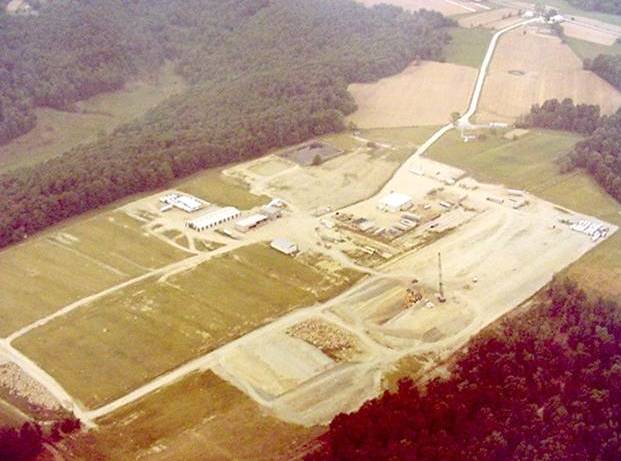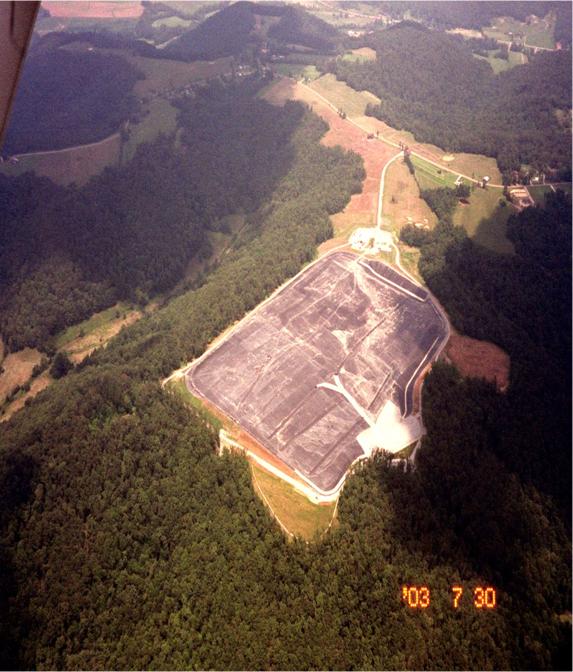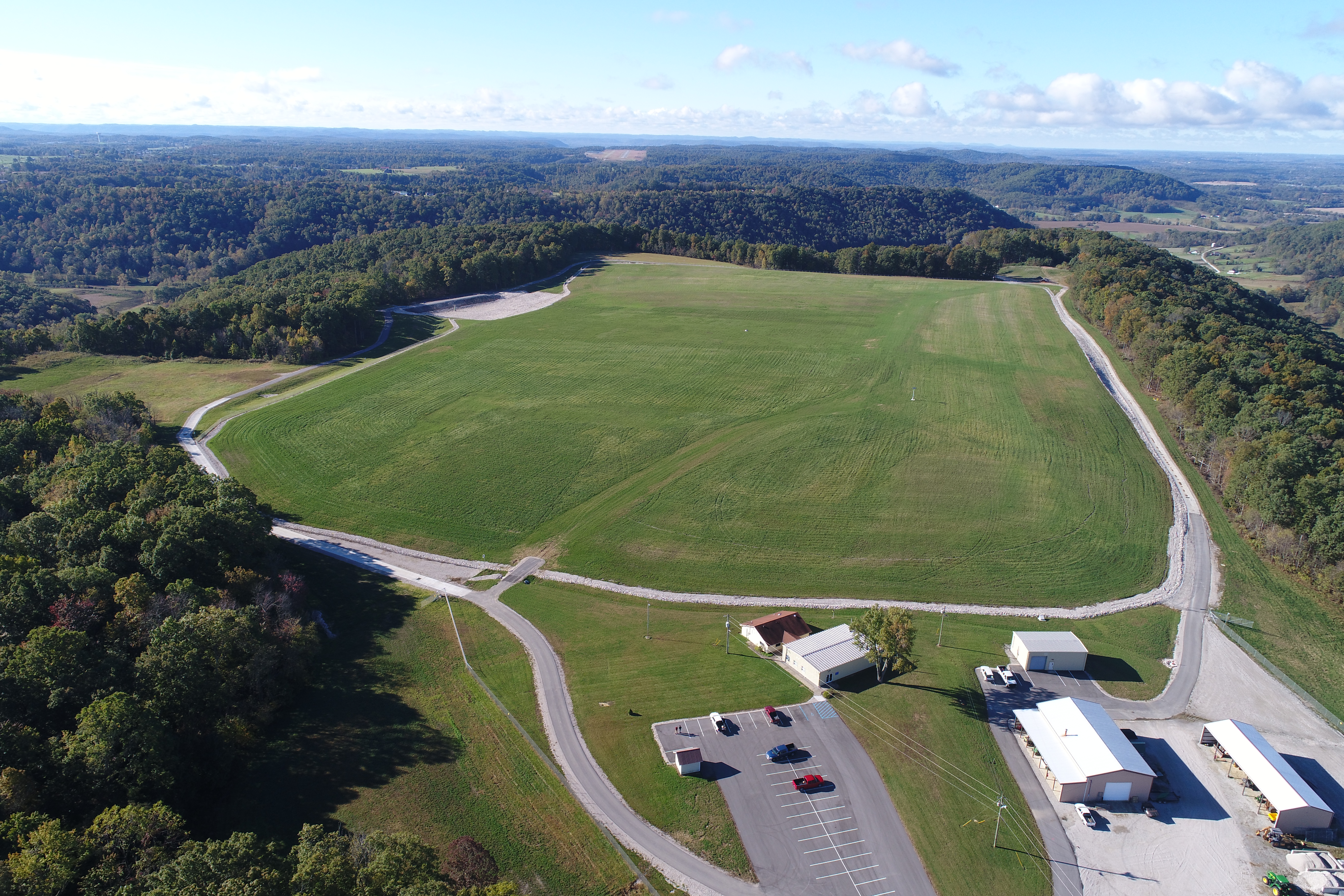The United States has been disposing of low-level nuclear waste in shallow land burial facilities since the early 1960s. A total of six commercial low-level radioactive waste disposal facilities have operated in the U.S. with only two remaining in operation today. One of the four that is no longer in operation is the Maxey Flats Disposal Site (MFDS). MFDS is located in northeastern Kentucky on the southern border of Fleming County approximately nine miles northwest of the city of Morehead.
MFDS consists of the original licensed 280 acres and approximately 662 acres of surrounding buffer zone. The controlled area is the fenced 60 acres that includes the 55-acre vegetative cap, office buildings, laboratory, garages, and equipment sheds.
 Early History
Early History
From 1963 to 1977, the Commonwealth of Kentucky, under authorities granted by the U.S. government, licensed private operators to dispose of low-level radioactive wastes from military ships and facilities, hospitals, universities and corporations at MFDS. During commercial operation, an estimated 4.7 million cubic feet of material were disposed that contained approximately 242,000 kilograms of source material (consisting of uranium and thorium or ores containing them), 2.4 million curies of byproduct materials, and 431 kilograms of special nuclear material (plutonium and enriched uranium). To assure proper closure and management, the Commonwealth has maintained the site since the time commercial operations were discontinued.
Cleanup Progress
 The remedial investigation and feasibility study was conducted from March 1987 through September 1991 under an Administrative Order by Consent. The record of decision was issued in September 1991. Meanwhile, between December 1988 and November 1989, Environmental Protection Agency (EPA) Emergency Response solidified 286,000 gallons of tanked leachate (radioactive contaminated trench water) because of significant leakage from the metal tanks; then from March 1991 to September 1992, EPA Emergency Response disposed of the solidified leachate blocks in an underground on-site trench and installed 30 acres of a temporary above-ground plastic, impermeable liner to prevent infiltration of rain into the waste trenches.
The remedial investigation and feasibility study was conducted from March 1987 through September 1991 under an Administrative Order by Consent. The record of decision was issued in September 1991. Meanwhile, between December 1988 and November 1989, Environmental Protection Agency (EPA) Emergency Response solidified 286,000 gallons of tanked leachate (radioactive contaminated trench water) because of significant leakage from the metal tanks; then from March 1991 to September 1992, EPA Emergency Response disposed of the solidified leachate blocks in an underground on-site trench and installed 30 acres of a temporary above-ground plastic, impermeable liner to prevent infiltration of rain into the waste trenches.
After lengthy negotiations lasting from June 1992 until June 1995, two consent decrees (one for the 50 de maximis parties and one for the 306 de minimis parties) arranged for cost allocation and for the performance of the remedial design (RD) and remedial action. After the required public comment periods, the U.S. District Court activated the decrees in April 1996; the RD for the first of two major cleanup phases (No. 1 - Leachate removal and disposal and No. 2 - Building demolition, on-site disposal and other items) began immediately thereafter.
Construction of Phase I and Phase II of the reinforced concrete bunkers (for disposal of solidified radioactive leachate and other contaminated materials) has been completed. Approximately 750,000 gallons of leachate were removed from within the landfill since current dewatering operations began in September 1998. Landfill dewatering operations were discontinued during early fall 2000.
Construction of an interim cap to prevent water infiltration with a perimeter drainage system that includes the groundwater interceptor channel was completed. To verify that the drainage system does not negatively impact erosion rates, erosion monuments have been installed for monitoring the rate of erosion.
The completion of the Initial Remedial Phase was declared in October 2003 by EPA. This initiated the Interim Maintenance Period of operation that was observed until stabilization data indicated that MFDS was ready for installation of a final cap.
In November 2012, MFDS was placed into the Final Closure Period which will include installation of a permanent vegetative cap, installation of permanent surface water control features, and installation of surface monuments to identify the location of buried waste. Final Closure Period construction was completed in September 2017 and the permanent surface water controls are functioning as designed, identification monuments are in place, and cap vegetation improves every year. Entrance into the Institutional Control Period is pending US EPA approval of the Institutional Control Period Work Plan.
Remedial work completed at MFDS has been under the guidance of the EPA Region IV headquartered in Atlanta, Ga., and has been completed in accordance with the consent decree signed in 1996. International Technology Corporation and Shaw Environmental Group performed the initial remedial construction. Final cap design was engineered by AECOM of Utah, whereas the final cap and accompanying features were constructed by a local company, The Walker Company from Mount Sterling.